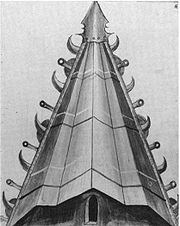
Bellifortis
Encyclopedia



De Re Militari
De Re Militari , also Epitoma Rei Militaris, is a treatise by the late Latin writer Vegetius about Roman warfare and military principles as a presentation of methods and practices in use during the height of Rome's power, and responsible for that power...
and Frontinus' anecdotal Strategemata, emphasising poliorcetics, or the art of siege warfare, but treating magic as a supplement to the military arts; it is "saturated with astrology
Astrology
Astrology consists of a number of belief systems which hold that there is a relationship between astronomical phenomena and events in the human world...
," remarked Lynn White, Jr. in a review of the first facsimile edition.
History of treatise
Konrad KyeserKonrad Kyeser
Konrad Kyeser was a German military engineer, author of Bellifortis , a book on siege engines popular throughout the 15th century...
wrote his treatise
Treatise
A treatise is a formal and systematic written discourse on some subject, generally longer and treating it in greater depth than an essay, and more concerned with investigating or exposing the principles of the subject.-Noteworthy treatises:...
between 1402 and 1405 when he was exiled from Prague
Prague
Prague is the capital and largest city of the Czech Republic. Situated in the north-west of the country on the Vltava river, the city is home to about 1.3 million people, while its metropolitan area is estimated to have a population of over 2.3 million...
to his hometown of Eichstatt
Eichstätt
Eichstätt is a town in the federal state of Bavaria, Germany, and capital of the District of Eichstätt. It is located along the Altmühl River, at , and had a population of 13,078 in 2002. It is home to the Katholische Universität Eichstätt-Ingolstadt, the lone Catholic university in Germany. The...
. Many of the illustrations for the book were made by German illuminators who were sent to Eichstatt after their own ousting from the Prague scriptorium
Scriptorium
Scriptorium, literally "a place for writing", is commonly used to refer to a room in medieval European monasteries devoted to the copying of manuscripts by monastic scribes...
. The work, which was not printed until 1967, survived in a single original presentation manuscript on parchment at University of Göttingen, bearing the date 1405, and in numerous copies, excerpts and amplifications, both of the text and of the illustrations, made in German lands.
Design of the book
Bellifortis was written in Latin and contained many elaborate illustrations of war weaponry. The manual discusses machines and technology that were old and new. It described weapons such as trebuchetTrebuchet
A trebuchet is a siege engine that was employed in the Middle Ages. It is sometimes called a "counterweight trebuchet" or "counterpoise trebuchet" in order to distinguish it from an earlier weapon that has come to be called the "traction trebuchet", the original version with pulling men instead of...
s, battering ram
Battering ram
A battering ram is a siege engine originating in ancient times and designed to break open the masonry walls of fortifications or splinter their wooden gates...
s, movable portable bridges, cannons, rockets, chariots, ships, mills, scaling ladders, incendiary devices, crossbows, and instruments of torture. The portrait of the author is called by its modern editor the first realistic portrait of an author since Antiquity
Ancient history
Ancient history is the study of the written past from the beginning of recorded human history to the Early Middle Ages. The span of recorded history is roughly 5,000 years, with Cuneiform script, the oldest discovered form of coherent writing, from the protoliterate period around the 30th century BC...
.
Kyeser’s viewpoint was that warfare in the broadest sense was most effective if looked at from all angles, which included astrology and sorcery. His manual presented the technology of the art of war through the association of education and Latin letters. The book was of a large expensive format. It had elaborate illustrations and lavish drawings of a large number of war devices and machines. The treatise was designed more for a prince or king than for an engineer. Kyeser believed his war manual would make other armies run in all directions.
His treatise often made reference to antiquity, especially the war tactics of Alexander the Great. He writes that Alexander had many war technical abilities. In one illustration he shows Alexander with a rocketlike war weapon in his hands with the mysterious letters: MEUFATON. In another illustration Alexander is shown as the supposed inventor of a very large war carriage. Kyeser writes that Alexander was not only a great inventor of war devices but was able to use them himself. Alexander is portrayed with magical abilities.
Dedication
Konrad dedicated his finished treatise to the weak Ruprecht IIIRupert of Germany
Rupert of Germany from the House of Wittelsbach was Elector Palatine from 1398 and German King from 1400 until his death...
in a bitter response to his exile. He emphasizes in the dedication the relationship of technical knowledge to technical skills. He writes of the German soldiers, Just as the sky shines with stars, Germany shines forth with liberal disciplines, is embellished with mechanics, and adorned with diverse arts.
At the end of the treatise, Kyeser gives a markedly unusual appearance of himself. He portrays himself as a dying worried person. He even provides his own epitaph, May my soul be joined to your very high one.

